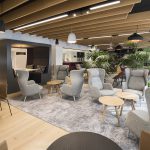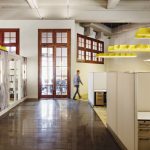Agile and activity-based working are real buzz words in today’s workplace – bringing with them the promise of optimal use of space and a happier and more productive workforce. The data and science behind the theory is strong but only effective if implemented correctly…
One of the biggest issues people introducing changes to the workspace face is the lack of uptake and poor response from team members.
The introduction of a new works system is inherently threatening – the human mind craves its own space, whether that is a small desk or a large office, it is home territory. Removing this space creates a natural defence against the change.
It is down to the people introducing the change to show that by losing the small square of territory, the worker gains the whole of the office as their territory.
How do you go about this?
One of the most important considerations is to make zones accessible to everyone. If you’ve invested in collaboration spaces, make sure they are near to people and easily accessible. Putting them in a corner away from most of the team means no one will use them. Informal meetings will continue to be clustered around small desks causing noise and disruption, leaving the dedicated collaboration space not used.
The same principle applies to phone booths and meeting rooms.
Think…
…Why do I need this space?
What am I trying to achieve? Is there a need for a space or did I see something nice in a brochure that I want? If it’s the latter and you don’t see a use for it, you don’t need it.
…What will it be used for?
If it’s for work where people need to concentrate, consider using muted, relaxing colours and putting it somewhere quiet. If it’s for a meeting room consider making it a stand-up solution, this will mean meetings are to the point. Other factors you might consider are sound proofing to make the space private or reduce the impact of noise in a collaboration space, lighting can also significantly impact the environment.
…Who will use it?
Put it near people who can and will use it. If the people who need to use it can see it and access it easily, they will use it.
…How does it integrate with the rest of the space?
Are people near to areas they can use? Have you put the pool table in the middle of a concentration zone? Are there power and charging points that are accessible?
…Could spaces become multifunctional?
As space becomes more valuable, think about how you can maximise it. If your staff break out area is only used during lunch but empty for the rest of the day, could this also be used for informal meetings, collaborative work or even customer meetings? If you have lots of fixed formal meeting rooms that are often empty, could the space be changed? Consider a different solution that could be used for collaborative working, informal meetings and breakout spaces. There are many solutions that can meet multiple requirements.
By Ross Kemp
Learn More About How We Can Help With Activity Based Office SolutionsImage supplied by Into the Nordic Silence




